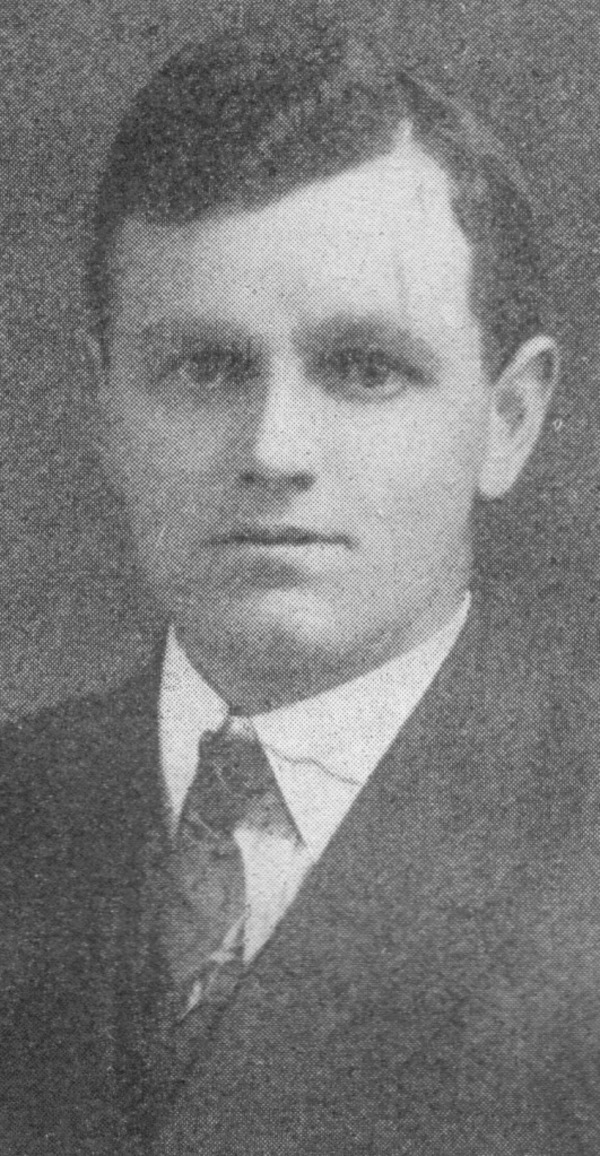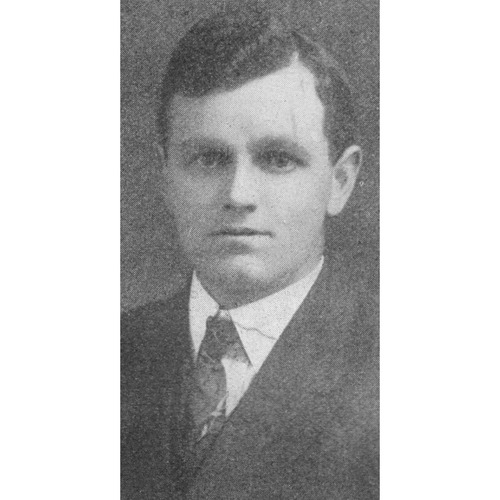
Source: Link
SUGRUE, JAMES LEONARD, carpenter, union organizer, labour leader, and office holder; b. 1 Sept. 1883 in Saint John, son of James Robert Sugrue and Mary Josephine Driscoll; m. there 10 June 1908 Estella Sophia Newman, and they had one son; d. there 24 June 1930.
James L. Sugrue grew up in the Irish working-class environment of west end Saint John. His mother was the daughter of immigrants from County Cork (Republic of Ireland); in 1877 she married James R. Sugrue, an immigrant from Kerry. The latter had become a teacher in the 1860s and taught at St Malachi’s School for several decades; “a kindly, amiable man of high ideals and exemplary life,” the older Sugrue “had the gift of imparting knowledge and of teaching his boys how to study and progress.” Their children included four daughters, one of whom became a teacher and another a stenographer and bookkeeper, and two sons, both of whom entered the city’s building trades.
As a young worker in the early years of the century, Sugrue boarded at the family home, now located in the south end. He married Estella Newman in 1908 and they remained lifelong residents of Saint John. Sugrue’s elder brother, John, became an officer of the local Bricklayers’ and Masons’ Union during this period, and James himself began to attract attention among the carpenters. With a long history of independent organization in the 19th century, the Saint John carpenters had joined the American Federation of Labor in October 1901, as Local 919 of the United Brotherhood of Carpenters and Joiners of America. In 1910 Sugrue became financial secretary (and in 1913 business agent) of the local as well as secretary-treasurer of the new Building Trades Council. Before he was 30 Sugrue had also been elected president of the Saint John Trades and Labor Council. Two years later, in 1914, “Jimmie” Sugrue ran as a labour candidate for city commissioner, winning a substantial increase in the labour vote.
Sugrue’s rise to prominence as a local union leader coincided with an upsurge in labour activism in Saint John. The carpenters raised their wages to $3 a day in 1911 and in 1913 were the first in their trade in the Maritimes to inaugurate the eight-hour day. Later that year the Labour Day celebrations featured “the most successful labour parade in many years.” The extension of unionism to unorganized workers proved more difficult. In 1913 a lock-out of more than 1,000 men at the city’s lumber mills lasted from June to September and ended without wage increases or union recognition. The following year the street railway workers also faced employers unwilling to countenance unions. The workers secured a conciliation board under the Industrial Disputes Investigation Act of 1907, naming Sugrue as their representative; he was able to persuade the board to call for recognition of the union and re-employment of its dismissed president, Fred Ramsey. When the company failed to agree, the workers went on strike in July 1914 and shut down public transportation for two days. Thousands of supporters rioted in the streets, overturning streetcars and attacking power installations, before a settlement was reached. For Sugrue, such events demonstrated that the cause of labour was important to the whole community in a major industrial centre such as Saint John. As he had explained in 1912, “In the long run we hope to so improve conditions here that the people won’t leave for the west in search of better wages and shorter hours of labor.” At the same time, he did not hesitate to call for more assistance from the international unions, reminding organizers that “Montreal is not the eastern extremity of Canada, despite the fact that some of our international executive officers seem to think so.” By 1914 Sugrue had succeeded in persuading the Trades and Labor Congress of Canada to hold its annual convention in New Brunswick for the first time.
One of Sugrue’s lasting contributions was the organization of a provincial federation of labour, which took place at a time when only British Columbia (1910) and Alberta (1912) had established such bodies. Efforts initiated by the Saint John Trades and Labor Council resulted in a preliminary meeting in September 1912 (which Sugrue did not attend), but the future of the federation was not assured until a more representative gathering took place a year later involving delegates from Saint John, Moncton, Fredericton, and Sackville. In the interim Sugrue had played a leading part in keeping the idea alive; in 1913 he was especially disappointed with the Fair Wage Schedule Act, for which he had lobbied on behalf of the council, and in the pages of the Eastern Labor News he argued that the legislative influence of labour could be applied more effectively through a provincial federation. At the organizational meeting on 16 Sept. 1913 Sugrue was elected president of the new federation; he and two other delegates were instructed to prepare a constitution and seek a charter from the TLCC. The first full convention of the New Brunswick Federation of Labor took place in Saint John on 20 Jan. 1914, with about 50 delegates in attendance. Sugrue was elected president, along with Frank Lister, Fredericton, as vice-president and Percy Douglas Ayer, Moncton, as secretary-treasurer. Within the year the federation reported 26 affiliated unions with a membership of 3,000 workers.
With Sugrue as its legislative representative, the federation pursued numerous objectives in Fredericton, including women’s suffrage. Increasingly, attention focused on workers’ compensation laws, a subject of marked concern to unionized employees on the docks and railways in Saint John and Moncton. The existing Workmen’s Compensation for Injuries Act (1903) required workers to go to court to establish employers’ liability for workplace accidents; awards were limited to a maximum of $1,500. Despite the election of labour-supported candidates such as Warren Franklin Hatheway in 1908, amendments failed to live up to expectations. More advanced legislation adopted by Ontario in 1914 – and in three other provinces in 1915 and 1916 – introduced state-sponsored no-fault insurance programs, backed by mandatory payroll assessments and with benefits administered by a compensation board. Sugrue lobbied provincial politicians for similar legislation, and in 1917 he and Frederick W. Daley of the longshoremen’s union were appointed (by a Conservative government) to a royal commission which held hearings throughout the province and reported in favour of a new compensation law. When the bill was introduced (by a Liberal government), labour unions rallied to support it against the opposition of employers. The resulting Workmen’s Compensation Act (1918) was considered exemplary progressive legislation at the time, although farmers, fishermen, domestic servants, and workers in the woods were excluded from coverage, and benefits in any claim were limited to a maximum of $3,500. Sugrue himself accepted a salaried position as one of three board members. In its first year of operation, 1919, the board completed consideration of 1,733 claims and approved compensation and pensions amounting to more than $100,000, numbers which increased substantially during the next ten years. Sugrue continued to serve on the board until his death in 1930 at 46 years of age. An apparent heart attack had forced him to reduce activities during the last two years of his life. His widow, who in 1923 had been appointed to a commission of inquiry into mothers’ pensions and minimum wages, survived him by 40 years.
The death of Sugrue at such an early age was considered a heavy loss both to organized labour and to provincial society. Described as “not only an able executive but an excellent speaker and a man of ideas,” he was remembered as well for his “kindly disposition.” Union members in Saint John recalled his occasional musical recitations at labour meetings; a union gathering in his honour featured a variety of musical numbers. Sugrue’s respectability was underlined by his participation in the Knights of Columbus, the Children’s Aid Society, and other charities; the New Freeman eulogized him as “a man who had given freely of his time in all movements for the betterment of the community.” In a city with a long history of labour organization in the 19th century, Sugrue promoted the extension of unionization to new groups of workers and collaboration around causes of common concern. While encouraging the transition from occupational loyalty to broader forms of labour solidarity, he remained a consistent supporter of the TLCC and the AFL. As a union leader who became a member of the province’s early labour bureaucracy, Sugrue was a pragmatist who believed in mobilizing labour’s influence within the existing political and economic structures; his success lends support to the theme of progressivism in the political history of the Maritime provinces. In promoting the recognition of unions and the enactment of reforms, Sugrue assisted New Brunswick workers and provincial society generally in establishing the regime of industrial legality and social legislation that came to characterize the 20th century.
[The author is grateful to Professor Robert H. Babcock for sharing references from his research in Saint John labour history. d.f.]
Arch. of the Diocese of Saint John, RBMB. PANB, RS6; RS141C5, F18983, no.080270; RS260/D. Eastern Labor News (Moncton, N.B.), 1909–13. Evening Times-Globe (Saint John), 24, 26 June 1930; 24 Jan. 1931. New Freeman (Saint John), 28 June 1930, 31 Jan. 1931. St. John Standard, 29–30 March, 5 April 1912; 2 Sept. 1913; 21 Jan., 15 April 1914. Telegraph-Journal (Saint John), 25, 27 June 1930. R. H. Babcock, “Blood on the factory floor: the workers’ compensation movement in Canada and the United States,” in Social welfare policy in Canada: historical readings, ed. R. B. Blake and Jeff Keshen (Toronto, 1995), 107–21; “Saint John longshoremen during the rise of Canada’s winter port, 1895–1922,” Labour (St John’s), 25 (1990): 15–46; “The Saint John street railwaymen’s strike and riot, 1914,” Acadiensis (Fredericton), 11 (1981–82), no.2: 3–27. Labour Gazette (Ottawa), 1 (1900–1)–30 (1930). Ian McKay, “Strikes in the Maritimes, 1901–1914,” in Labour and working-class history in Atlantic Canada: a reader, ed. David Frank and G. S. Kealey (St John’s, 1995), 190–232. G. R. Melvin, History of New Brunswick Federation of Labour, 1914–1933 (n.p., n.d.). N.B., Acts, 1903–30; Workmen’s Compensation Board, Annual report (Saint John), 1919–30. “Obituary,” Canadian Congress Journal (Ottawa), 9 (1930), no.7: 29. Report of proceedings at a conference concerning Workmen’s Compensation Act, held at St. John on Thursday and Friday 10th and 11th January, 1924 (n.p., 1924). W. Y. Smith, “Axis of administration: Saint John reformers and bureaucratic centralization in New Brunswick, 1911–1925” (ma thesis, Univ. of N.B., Fredericton, 1984). Trades and Labor Congress of Canada, Report of the proc. of the annual convention ([Ottawa]), 18 (1902)–34 (1918).
Cite This Article
David Frank, “SUGRUE, JAMES LEONARD,” in Dictionary of Canadian Biography, vol. 15, University of Toronto/Université Laval, 2003–, accessed December 29, 2025, https://www.biographi.ca/en/bio/sugrue_james_leonard_15E.html.
The citation above shows the format for footnotes and endnotes according to the Chicago manual of style (16th edition). Information to be used in other citation formats:
| Permalink: | https://www.biographi.ca/en/bio/sugrue_james_leonard_15E.html |
| Author of Article: | David Frank |
| Title of Article: | SUGRUE, JAMES LEONARD |
| Publication Name: | Dictionary of Canadian Biography, vol. 15 |
| Publisher: | University of Toronto/Université Laval |
| Year of publication: | 2005 |
| Year of revision: | 2005 |
| Access Date: | December 29, 2025 |



